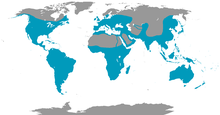Loading AI tools
Order of birds From Wikipedia, the free encyclopedia
The Coraciiformes /kɒrəˈsaɪ.ɪfɔːrmiːz/ are a group of usually colourful birds including the kingfishers, the bee-eaters, the rollers, the motmots, and the todies. They generally have syndactyly, with three forward-pointing toes (and toes 3 & 4 fused at their base), though in many kingfishers one of these is missing.[citation needed] The members of this order are linked by their “slamming” behaviour, thrashing their prey onto surfaces to disarm or incapacitate them.[1]
| Coraciiformes Temporal range: | |
|---|---|
 | |
| European roller Coracias garrulus | |
| Scientific classification | |
| Domain: | Eukaryota |
| Kingdom: | Animalia |
| Phylum: | Chordata |
| Class: | Aves |
| Clade: | Picodynastornithes |
| Order: | Coraciiformes Forbes, 1884 |
| Families | |
|
For prehistoric taxa, see text. | |
 | |
| Global distribution of the kingfisher and allies. | |
This is largely an Old World order, with the representation in the New World limited to the dozen or so species of todies and motmots, and a mere handful of the more than a hundred species of kingfishers.
The name Coraciiformes means "raven-like". Specifically, it comes from the Latin language "corax", meaning "raven" and Latin "forma", meaning "form".[2]
The phylogenetic relationships between the six families in the order Coraciiformes is shown below. The cladogram is based on a large study by Richard Prum and colleagues published in 2015.[3] The number of species in each family is taken from the list maintained by Frank Gill, Pamela C. Rasmussen and David Donsker on behalf of the International Ornithological Committee (IOC).[4]
| Coraciiformes |
| ||||||||||||||||||||||||||||||
Several extinct coraciiform families are only known from Paleogene fossils. They probably belong to the basal group and are sometimes difficult to assign because they were even closer still to the Piciformes (see also Neanis). In addition, there are some prehistoric genera which are likewise difficult to place into a family. At least the Eocoraciidae are very basal, but the Late Eocene (some 35 mya) Geranopteridae form a superfamily Coracioidea with the extant rollers and ground-rollers already (Mayr & Mourer-Chauviré 2000). A few prehistoric taxa of the present-day families have been described; see the family articles for details.
Unresolved
A recent study suggest that the following families may belong to a separate order called Bucerotiformes. The results still in dispute though.[5]
The Leptosomidae (cuckoo roller) probably do not belong here. The trogons are sometimes placed here as a family Trogonidae. The Late Eocene Palaeospizidae are sometimes also placed in the Coraciiformes, as are the Early to Middle Eocene Primobucconidae and the Middle Eocene to Early Oligocene Sylphornithidae. The Primobucconidae at least indeed seem to belong here.
Basal group
Suborder Alcedines
Seamless Wikipedia browsing. On steroids.
Every time you click a link to Wikipedia, Wiktionary or Wikiquote in your browser's search results, it will show the modern Wikiwand interface.
Wikiwand extension is a five stars, simple, with minimum permission required to keep your browsing private, safe and transparent.